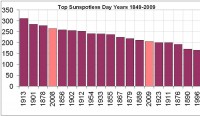By Stephen Cauchi, Sydney Morning Herald
THE sun has gone quiet, with a sharp decline in sunspot numbers in the past couple of years - possibly heralding the start of a solar depression that could lead to cooler weather on Earth. During the past millennium, whenever the sun experienced long periods of low sunspot numbers, Earth had equally long, cold snaps. The number of sunspots - dark and intensely magnetic blotches on the sun’s surface - are at their lowest since 1913.
“This is the quietest sun we’ve seen in almost a century,” said NASA solar forecaster David Hathaway.
“Since the space age began in the 1950s, solar activity has been generally high. Five of the most intense solar cycles on record have occurred in the past 50 years. We’re just not used to this type of deep calm.”
Sunspots cause other solar activity such as solar flares and coronal mass ejections, radiation from which can interfere with Earth’s magnetic field, upper atmosphere and, many scientists believe, Earth’s climate.
There have been more than 200 spotless days so far this year and scientists expect the count to reach 290 by year’s end. Last year there were 266 spotless days, the previous lowest number recorded since 1913, when there were 311 spotless days.

Top 20 years with the most sunspotless days since 1849. As of September 13, we will be at 205 this year rapidly approaching the 266 days in 2008.
Sunspot numbers move in regular cycles of 11 years, so the timing of this quiet spell is not unexpected. What is unexpected is the depth and length of the spell. Some scientists believe it may be the start of a long period when the entire cycle is depressed, as it has been several times during the past millennium.
The most famous depression was the Maunder Minimum of 1645 to 1715 in which sunspots nearly vanished for 70 years. It coincided with the coldest period of the Little Ice Age.
“People are wondering about whether we’re going into another Maunder Minimum or not,’’ said Iver Cairns, from the University of Sydney’s school of physics. “I think the balance of opinion is that it’s too early to tell. But it could be very significant.”
Professor Cairns said the fluctuation in sunspot numbers was not fully understood but it was linked to the “magnetic dynamo of the sun”.
It was equally uncertain how - or indeed if - changes in solar activity affect Earth’s climate.
“What some people think is that energetic particles from the sun get into Earth’s magnetosphere and some of them get down to the ozone layer - you’re talking 40 to 80 kilometres above the surface of Earth. They alter the chemistry of that layer...That changes the chemistry of other layers of the atmosphere, leading to winds and changes in temperature,” he said. See post here.




